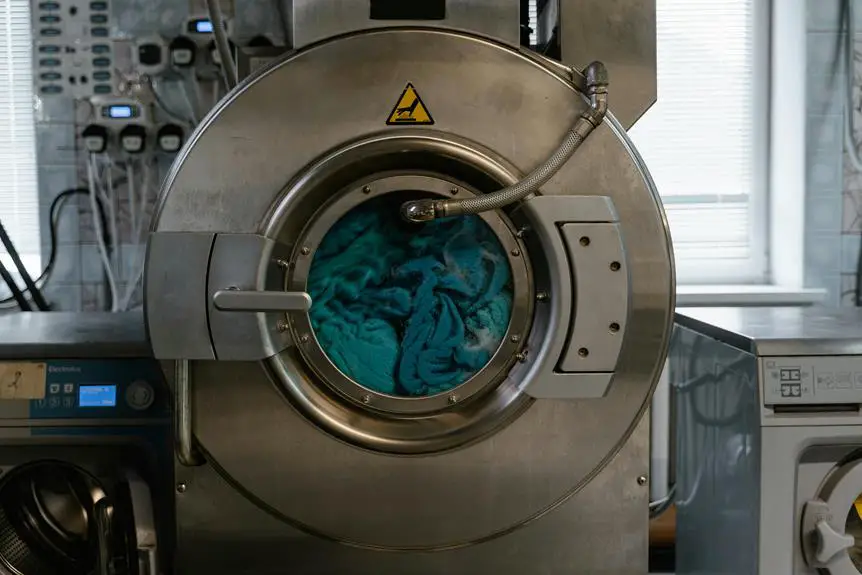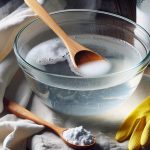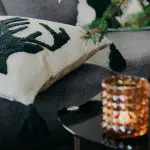When it comes to bleaching fabrics, knowing the right agents for each type is crucial to achieving the desired outcome without damaging your materials. You might think that a one-size-fits-all approach works, but that's rarely the case. For instance, cotton and linen respond differently to specific bleaches, and synthetic fibers have their own set of needs. If you're wondering which agents will give you the best results while preserving the integrity of your fabrics, you won't want to miss the essential tips ahead.
Table of Contents
Key Takeaways
- Hydrogen peroxide is a mild and effective bleaching agent for natural fibers like cotton and linen, ensuring minimal damage when diluted properly.
- Oxygen bleach works well for both natural and synthetic fabrics, providing gentle brightening without compromising fabric integrity.
- Chlorine bleach is powerful for white cotton but should be diluted to prevent weakening of the fibers.
- Lemon juice serves as an eco-friendly option for a subtle brightening effect on various fabrics.
Understanding Fabric Types
When choosing a bleaching agent, it's essential to understand the different types of fabrics you'll be working with. Each fabric type reacts differently to bleaching agents, so knowing their characteristics can save you from potential mishaps.
First, consider natural fibers like cotton, linen, and wool. These fabrics often hold up well against bleach, but the concentration of the agent matters. Too strong a solution can weaken the fibers, causing damage over time.
Next, look at synthetic fibers such as polyester and nylon. These materials generally resist bleach better than natural fibers, but they can still be discolored or damaged if you use harsh agents. Always check the care label before proceeding.
Lastly, blended fabrics can be tricky. They often combine natural and synthetic fibers, leading to unpredictable results when bleached. If you're unsure about how a particular blend will react, it's wise to test a small, inconspicuous area first.
Understanding these nuances will help you choose the right bleaching agent for your specific fabric, ensuring effective results without compromising the integrity of your textiles.
Best Bleaching Agents for Cotton
For cotton fabrics, choosing the right bleaching agent can enhance your results while preserving the material's integrity.
One of the best options you can use is hydrogen peroxide. This mild bleaching agent works effectively without compromising the strength of your cotton, making it ideal for whites and colors alike. You can mix it with water in a 1:1 ratio for safe application.
Another excellent choice is oxygen bleach, often available in powder form. You'll find it gentle yet effective, especially for stained items. Just dissolve it in warm water and soak your cotton fabric as directed on the packaging.
Chlorine bleach is a powerful option, but you should use it cautiously. It can produce excellent results on white cotton, but it may weaken the fibers over time. If you go this route, always dilute it properly and follow the instructions closely.
Lastly, consider using lemon juice as a natural bleaching agent. It's safe and eco-friendly, providing a subtle brightening effect while also being gentle on your cotton.
Whichever agent you choose, always test on a small, inconspicuous area first to ensure the desired results.
Effective Solutions for Linen
To effectively bleach linen, consider using hydrogen peroxide, which brightens your fabric without damaging its fibers. This mild bleaching agent is an excellent choice because it's less harsh than traditional chlorine bleach and works well with the natural fibers of linen.
Begin by mixing a solution of hydrogen peroxide and water, using a ratio of one part hydrogen peroxide to three parts water. Soak your linen in this solution for about 30 minutes. Keep an eye on the fabric to ensure it doesn't become overly bleached.
After soaking, rinse the linen thoroughly in cold water to remove any remaining solution. If you're dealing with stubborn stains, you can apply a small amount of hydrogen peroxide directly to the affected area before soaking.
For an additional boost, consider adding a few tablespoons of baking soda to the mix. It helps to enhance the whitening effect while also deodorizing your linen.
Always test any bleaching solution on a small, inconspicuous area first to check for colorfastness. By following these steps, you can rejuvenate your linen and keep it looking fresh and vibrant.
Safe Options for Synthetic Fabrics
If you're looking to safely bleach synthetic fabrics, consider using oxygen bleach, which is gentle yet effective for brightening without risking damage. Unlike chlorine bleach, oxygen bleach breaks down into harmless components and works well on materials like polyester, nylon, and spandex.
Before you start, always check the care label on your fabric. Some synthetics may have specific instructions, so you want to ensure you're using the right method. To prepare, dilute the oxygen bleach in water according to the package instructions. You'll typically want to soak the fabric in this solution for about 30 minutes for optimal results.
When you're ready, rinse the fabric thoroughly to remove any residue. This step's crucial, as lingering bleach can weaken fibers over time. If you're dealing with stubborn stains, consider applying a paste of oxygen bleach and water directly to the affected area before soaking.
Lastly, avoid exposing synthetic fabrics to high heat when drying, as it can set stains and damage the material. Instead, air dry or tumble dry on a low setting. By following these tips, you can safely refresh your synthetic items without fear of damage.
Delicate Fabrics and Bleaching Tips
When dealing with delicate fabrics, it's essential to choose a gentle bleaching method to prevent damage while still achieving a brighter look. Here are some tips to help you safely bleach your delicate garments:
- Test First: Always test the bleaching agent on a small, inconspicuous area of the fabric. This way, you can check for any adverse reactions before applying it to the entire piece.
- Dilute the Bleach: Use a diluted solution of bleach, typically one part bleach to ten parts water. This reduces the strength while still providing the necessary whitening effect.
- Limit Soaking Time: Don't soak delicate fabrics for too long. A quick dip of 5-10 minutes is usually sufficient. Keep an eye on the fabric to avoid over-bleaching.
- Rinse Thoroughly: After bleaching, rinse the fabric well with cold water to remove any residual bleach. This step is crucial to prevent further damage or discoloration.
Frequently Asked Questions
Can I Bleach Colored Fabrics Without Damaging Them?
You can't safely bleach colored fabrics without risking damage. Most bleach will fade or ruin the colors. If you need to lighten, consider gentler alternatives specifically designed for colored clothing to avoid unwanted results.
How Do I Test Fabric for Bleaching Compatibility?
To test fabric for bleaching compatibility, you can apply a small amount of diluted bleach on a hidden area. Wait a few minutes, then rinse and check for color change or damage before proceeding.
Are There Eco-Friendly Bleaching Agents Available?
Yes, there are eco-friendly bleaching agents available! You can use hydrogen peroxide, baking soda, or lemon juice. These alternatives effectively brighten fabrics while being gentler on the environment than traditional chemical bleaches.
What Safety Precautions Should I Take While Bleaching?
When you're bleaching, always wear gloves and a mask to protect your skin and lungs. Work in a well-ventilated area, and avoid mixing bleach with other chemicals to prevent dangerous reactions. Stay safe!
How Can I Remove Bleach Stains From Fabrics?
To remove bleach stains from fabrics, you can try rinsing the area with cold water immediately. If that doesn't work, consider using a fabric dye or a color remover to restore the fabric's original hue.
- How Does Ring Spun Cotton Affect Garment Fit and Shape Retention? - August 13, 2024
- What Are the Challenges in Producing Ring Spun Cotton? - August 13, 2024
- Is Ring Spun Cotton Suitable for Plus-Size Clothing? - August 13, 2024






